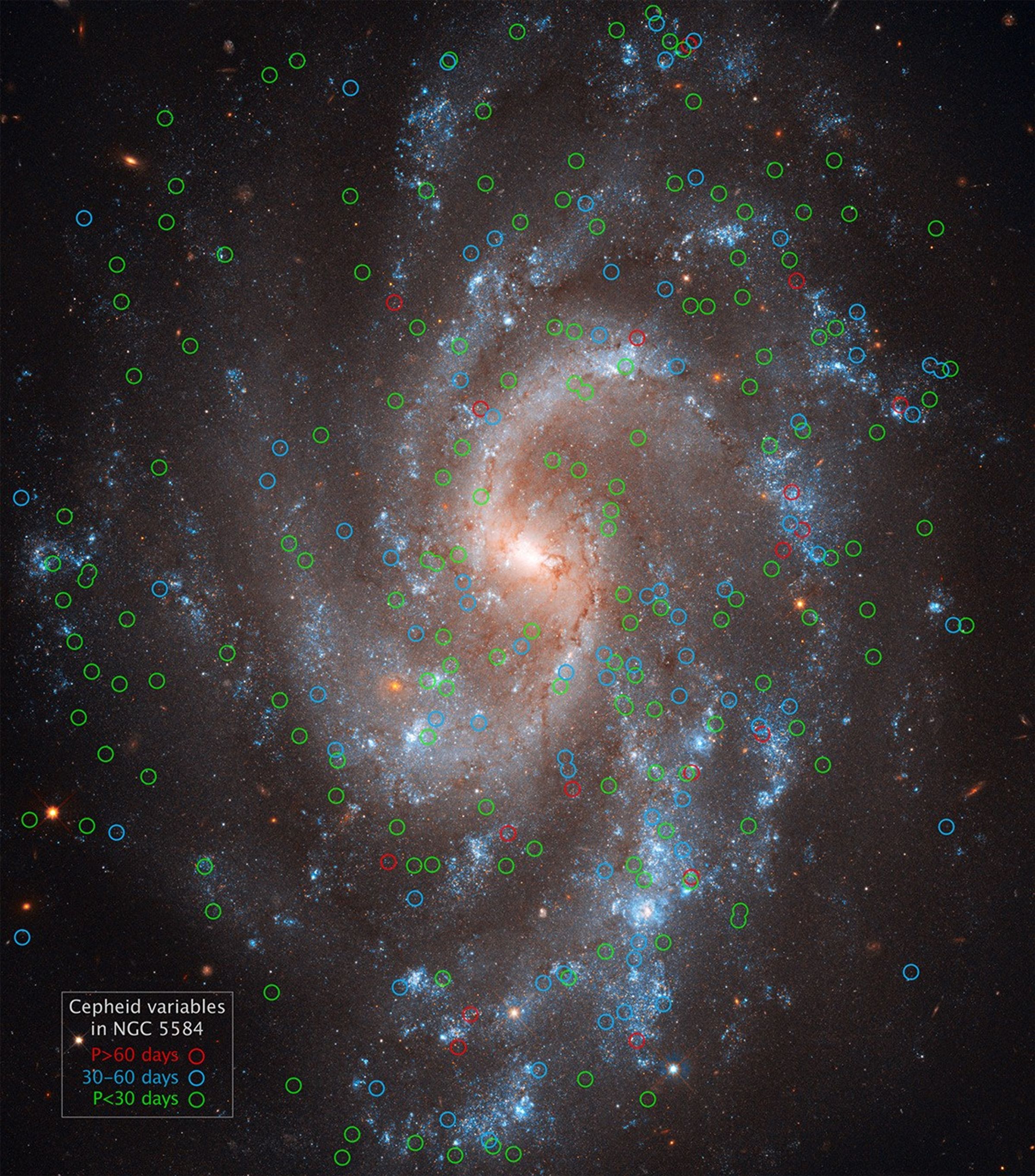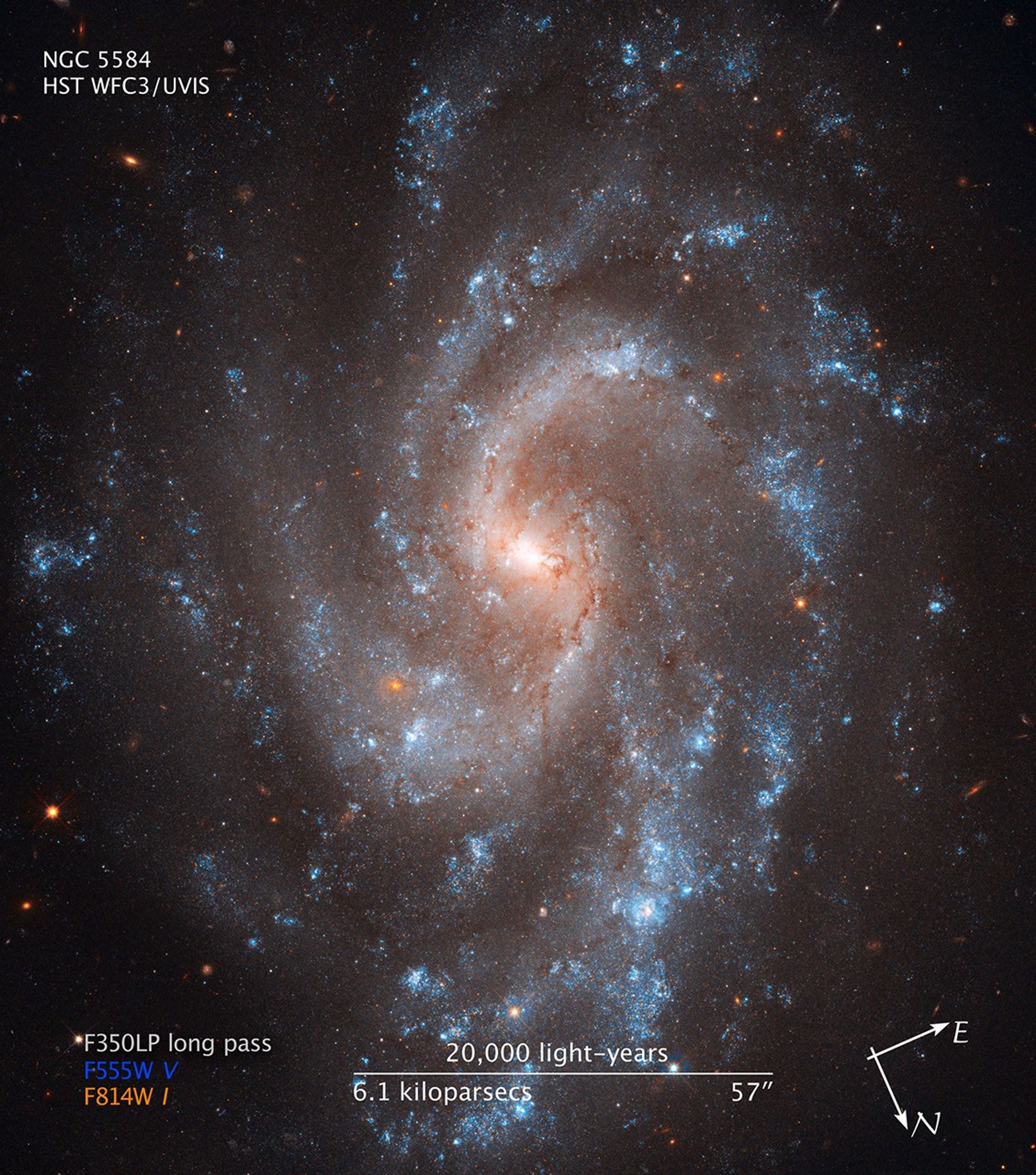1 min read
Hubble’s View of NGC 5584

The brilliant, blue glow of young stars traces the graceful spiral arms of galaxy NGC 5584 in this Hubble Space Telescope image. Thin, dark dust lanes appear to be flowing from the yellowish core, where older stars reside. The reddish dots sprinkled throughout the image are largely background galaxies.
Among the galaxy's myriad stars are pulsating stars called Cepheid variables and one recent Type Ia supernova, a special class of exploding stars. Astronomers use Cepheid variables and Type Ia supernovae as reliable distance markers to measure the universe's expansion rate. NGC 5584 was one of eight galaxies astronomers studied to measure the universe's expansion rate. In those galaxies, astronomers analyzed more than 600 Cepheid variables, including 250 in NGC 5584.
Cepheid variables pulsate at a rate matched closely by their intrinsic brightness, making them ideal for measuring distances to relatively nearby galaxies. Type Ia supernovae flare with the same brightness and are brilliant enough to be seen from relatively longer distances.
Astronomers search for Type Ia supernovae in nearby galaxies containing Cepheid variables so they can compare true brightness of both types of stars. They then use that information to calibrate the measurement of Type Ia supernovae in far-flung galaxies and calculate their distance from Earth. Once astronomers know accurate distances to galaxies near and far, they can determine the universe's expansion rate.
The image is a composite of several exposures taken in visible light between January and April 2010 with Hubble's Wide Field Camera 3.
NGC 5584 resides 72 million light-years away in the constellation Virgo.
About the Object
- R.A. PositionR.A. PositionRight ascension – analogous to longitude – is one component of an object's position.14h 22m 23.76s
- Dec. PositionDec. PositionDeclination – analogous to latitude – is one component of an object's position.00° 23' 15.61"
- ConstellationConstellationOne of 88 recognized regions of the celestial sphere in which the object appears.Virgo
- DistanceDistanceThe physical distance from Earth to the astronomical object. Distances within our solar system are usually measured in Astronomical Units (AU). Distances between stars are usually measured in light-years. Interstellar distances can also be measured in parsecs.About 72 million light-years (22 million parsecs)
- DimensionsDimensionsThe physical size of the object or the apparent angle it subtends on the sky.The image is 2.4 arcminutes (50,000 light-years or 15,000 parsecs) wide.
About the Data
- Data DescriptionData DescriptionProposal: A description of the observations, their scientific justification, and the links to the data available in the science archive.
Science Team: The astronomers who planned the observations and analyzed the data. "PI" refers to the Principal Investigator.The image was created from Hubble data from proposal 11570: A. Riess (STScI/JHU), L. Macri (Texas A&M University), C. Kochanek and K. Stanek (Ohio State University), A. Filippenko and W. Li (University of California, Berkeley), S. Casertano and H. Ferguson (STScI), and L. Greenhill (Harvard-Smithsonian Center for Astrophysics). The science team comprises: A. Riess (STScI/JHU), L. Macri (Texas A&M University), S. Casertano (STScI), H. Lampeitl (University of Portsmouth, UK), H. Ferguson (STScI), A. Filippenko (University of California, Berkeley), S. Jha (Rutgers University), W. Li (University of California, Berkeley), and R. Chornock (Harvard-Smithsonian Center for Astrophysics). Note: Hubble data of NGC 5584 taken with WFC3/IR filters, along with numerous other galaxies, were used in these science results. - InstrumentInstrumentThe science instrument used to produce the data.HST>WFC3/UVIS
- Exposure DatesExposure DatesThe date(s) that the telescope made its observations and the total exposure time.January-April, 2010, Exposure Time: 20.8 hours
- FiltersFiltersThe camera filters that were used in the science observations.Blue:
- Object NameObject NameA name or catalog number that astronomers use to identify an astronomical object.NGC 5584
- Object DescriptionObject DescriptionThe type of astronomical object.Spiral Galaxy
- Release DateMarch 14, 2011
- Science ReleaseNASA’s Hubble Rules Out One Alternative to Dark Energy
- CreditNASA, ESA, A. Riess (STScI/JHU), L. Macri (Texas A&M University), and the Hubble Heritage Team (STScI/AURA)

This image is a composite of separate exposures acquired by the WFC3 instrument on HST. Several filters were used to sample broad wavelength ranges. The color results from assigning different hues (colors) to each monochromatic (grayscale) image associated with an individual filter. In this case, the assigned colors are: White: F350LP (Long Pass) Blue: F555W (V) Orange: F814W (I)

Related Images & Videos

Cepheids in Spiral Galaxy NGC 5584
This illustration shows the location of Cepheid variables found in the spiral galaxy NGC 5584. Ultraviolet, visible, and infrared data taken with Hubble's Wide Field Camera 3 in 2010 reveal Cepheids of varying periods. Those stars with periods of less than 30 days and between 30...
Share
Details
Claire Andreoli
NASA’s Goddard Space Flight Center
Greenbelt, Maryland
claire.andreoli@nasa.gov





























